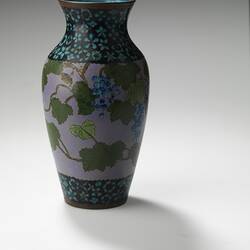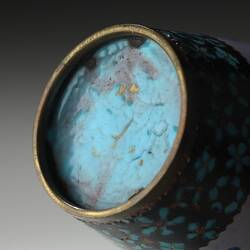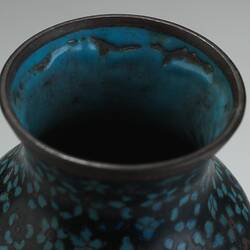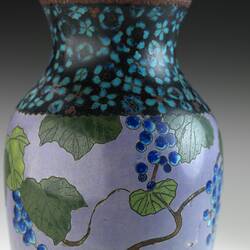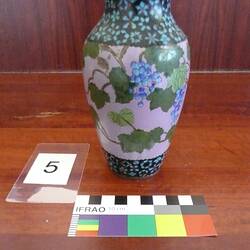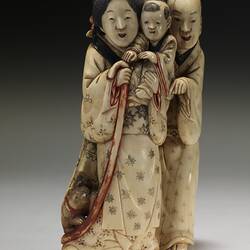Summary
Cloisonné vase manufactured in Nagoya, Aichi Prefecture, Japan during the early Meiji period (1868-1880).
The process of inlaid enamelling (cloisonné) in Japan dates back to the 8th century. Popular throughout Japan over the centuries, technical developments in the 19th century saw it reach its zenith in the Meiji period (1868-1912). The most important technical development being the 'Yuusen-shippo' method developed by Tsunekichi Kaji in 1833, in which fine filigree wires of brass, gold or silver are glued rather than soldered onto base metal. Then in 1868 Tsukamoto Kaisuke developed a process of applying filigree wire and fired enamel to ceramic pottery, known as 'Jitai Shippo'. And in 1879, Namikawa Sosuke (1847 to 1910) developed a technique for creating totally wireless enamel ware, 'Musen-shippo'. The elimination of wire enabled the artisan to create elaborate scenic designs that were not possible with wire.
Physical Description
Tapering cylindrical with wide lip. Decorated around neck and base with dark blue ground and stylised floral motif. Body decorated with lilac background covered in vines laden with indigo blue grapes. No markings.
More Information
-
Collection Names
-
Collecting Areas
-
Acquisition Information
Cultural Gifts Donation from Dr Will Twycross, 23 Jan 2009
-
Acknowledgement
Donated through the Australian Government's Cultural Gifts Program
-
Place & Date Made
-
Place & Date Exhibited
Royal Exhibition Building (REB), Carlton, Greater Melbourne, Victoria, Australia, 1880-1881
-
Collector
Mr John Twycross, Elsternwick, Greater Melbourne, Victoria, Australia, 1881
-
Classification
Royal exhibition building, International exhibitions, Exhibition heritage
-
Category
-
Discipline
-
Type of item
-
Overall Dimensions
80 mm (Width), 160 mm (Height)
-
Maximum dimensions
161 mm (Height), 265 mm (Circumference)
Measurement From Conservation.
-
Keywords
Cloisonné Metalwork, Decorative Arts, Exhibitions: Melbourne International, 1880-1881, Japanese Art, Royal Exhibition Building


